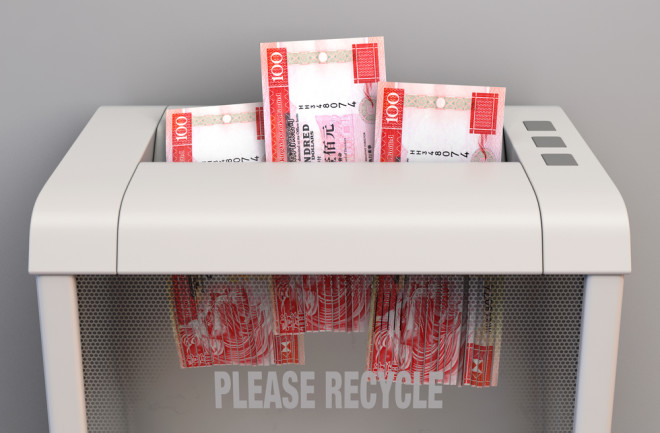The fate of old notes is a critical issue for central banks that oversee their disposal. These notes cannot be thrown away like ordinary rubbish. Instead, central banks have developed standards to ensure the disposal is safe and secure.
This often involves a type of shredding that slices each note into hundreds of tiny pieces, each typically smaller than about thirty square millimeters. The shredded paper, or increasingly plastic, can then be disposed of, or recycled, off site.
Some central banks have even taken to selling shredded banknotes as souvenirs. And this raises the question of whether it is possible to reassemble the notes and reclaim them at face value.
Clearly manual re-assembly is a challenging task. But now Chung Kong, a PhD student at Hong Kong University, has shown that computer vision can help reassemble shredded notes at least partially.
Kong became intrigued after noticing that the Hong Kong Monetary Authority visitor center sells souvenir paperweights filled with shredded notes. Each paperweight, it says, contains the remains of 138 notes each worth HDK 1000 (equivalent to just over $100).
Vision System
Kong imagined that, when reassembled, the notes ought to be worth HDK138,000. A tempting amount. And since computer vision systems can already solve jigsaw puzzles, he began the task of testing whether such a system might help reassemble a complete note.
Kong’s approach was straightforward. He first scanned complete versions of the HDK1000 notes to create “ground truth images”. He then broke open the paperweights, scanned each shredded piece, and cropped it to a rectangular form. Finally, he used a machine vision system to match the pattern on the shredded piece to a location on the ground truth image.
This process was hugely successful. It appears to be straightforward for a computer to find these locations.
However, there is another crucial step that Kong does not deal with in his paper. The shredded pieces are irregular shapes but the matching is done with parts of the patterns cropped into rectangles.
The problem is that the pieces may not have all come from the same note. So even if the computer vision system were to find matches for an entire note, there is no guarantee that those irregular pieces would fit together to form a complete note.
Then there is the problem of serial numbers. These cannot be matched with a ground truth template because the original number is unknown. So some other approach is required to reassemble this area of a banknote. One possibility is to fit together the serial number pieces by shape, but Kong does not address this issue.
Indeed, the problem is more severe than Kong appears to have appreciated. A key part of the security of bank note shredding systems is that they mix up the shredded pieces from a large number of banknotes, precisely to make reassembly almost impossible. That more or less dooms his efforts from the start, even with computer vision.
Paper, Stone, Scissors
To add insult to injury, Kong also seems to have been short-changed by the Hong Kong Monetary Authority visitor center. After breaking open a couple of paperweights, he found they weren’t packed full of shredded banknotes after all but instead contained stones, presumably to make up the mass and volume. After careful weighing, he concluded the paperweights contained only 20 notes rather than the claimed 138.
Finally, there is the question of whether the reassembled notes can be legitimately reclaimed, even if he were somehow able to reassemble them. It is easy to imagine that a central bank would refuse such a request, particularly if it maintained a database of the serial numbers of destroyed notes. Indeed, advanced shredding systems do exactly this.
Kong ends his paper by saying that the paperweight souvenir is no longer on sale in the visitor center. Perhaps that’s just as well.
Ref: The possibility of making $138,000 from shredded banknote pieces using computer vision : arxiv.org/abs/2401.06133

